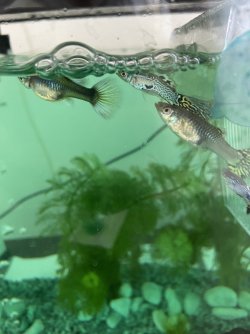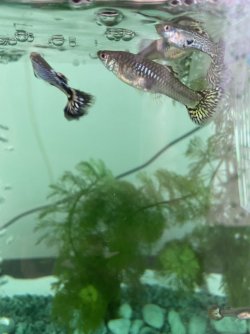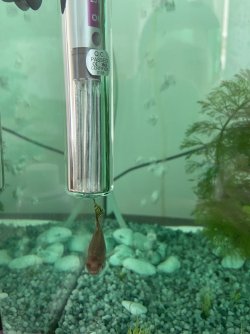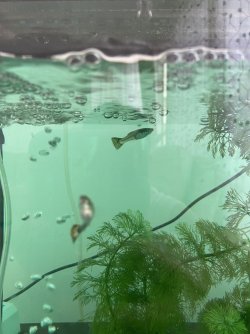What are the ammonia, nitrite, nitrate and pH levels in numbers?
How long has the tank been set up for?
How long have you had the fish?
Have you added anything to the tank in the 2 weeks before this started?
-------------------
Need better pictures of the male and maybe a 1 minute video of him moving or sitting there.
Clamped fins on the female is either poor water quality or an external infection (usually protozoan).
-------------------
White spot does not cause clamped fins. Fish with white spot will rub on objects in the tank, breath heavily and get little white dots on their body and fins. After a few days the white dots fall off and a few days after that, more white dots appear.
White spot can be treated with heat. Raise the water temperature to 30C (86F) and keep it there for 2 weeks, or at least 1 week after all the dots have gone. No chemicals needed. Just increase aeration/ surface turbulence when raising the temperature to maximise the oxygen level in the water.
-------------------
Do a 75% water change and gravel clean the substrate every day for a week.
Make sure any new water is free of chlorine/ chloramine before it's added to the tank.
Add some salt
-------------------
SALT
You can add rock salt (often sold as aquarium salt), sea salt or swimming pool salt to the aquarium at the dose rate of 1 heaped tablespoon per 20 litres of water. If there is no improvement after 48 hours you can double that dose rate so there is 2 heaped tablespoons of salt per 20 litres.
Keep the salt level like this for at least 2 weeks but no longer than 4 weeks otherwise kidney damage can occur. Kidney damage is more likely to occur in fish from soft water (tetras, Corydoras, angelfish, Bettas & gouramis, loaches) that are exposed to high levels of salt for an extended period of time, and is not an issue with livebearers, rainbowfish or other salt tolerant species.
The salt will not affect the beneficial filter bacteria, fish, plants, shrimp or snails.
After you use salt and the fish have recovered, you do a 10% water change each day for a week using only fresh water that has been dechlorinated. Then do a 20% water change each day for a week. Then you can do bigger water changes after that. This dilutes the salt out of the tank slowly so it doesn't harm the fish.
If you do water changes while using salt, you need to treat the new water with salt before adding it to the tank. This will keep the salt level stable in the tank and minimise stress on the fish.
When you first add salt, add the salt to a small bucket of tank water and dissolve the salt. Then slowly pour the salt water into the tank near the filter outlet. Add the salt over a couple of minutes.











